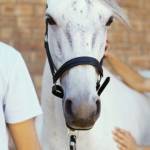Kissing Spines in Horses

Kissing spines refers to a condition in horses in which two or more of the spinous processes (the flanges of bone sticking up from each vertebra in the spine) are positioned so that they touch or rub against each other. Horse with kissing spines may develop back pain, bone cysts, arthritic changes, and other problems.
It’s tempting to blame kissing spine problems on the weight of a rider, especially in young horses or those that are not in good physical condition. However, researchers studying the skeletons of long-extinct horses have found evidence of kissing spines in these animals, so while weight-carrying does reposition the shape of the spine to some extent, not all problems with kissing spines are related to the presence of a rider.
A horse’s back pain may be shown as fidgeting when being groomed or tacked up, nipping or kicking while having the girth tightened, and jigging or bolting as a rider mounts and sits down in the saddle. Another common sign is misbehavior under saddle (bucking, rearing, kicking out, head-tossing). Horses that drag a rear toe, are stiff to one side, won’t pick up a canter lead, are awkward in gait transitions, have shifting lameness, and won’t flex or collect may also be showing signs of back discomfort.
This condition is found most often in horses of Thoroughbred, Quarter Horse, and Warmblood breeding, and is quite common in dressage horses. Many dressage horses are Thoroughbreds or Warmbloods, and the demands of dressage (engagement of the hind end, periods of sitting trot by the rider, and so on) may allow pain from kissing spines to be noticed more readily than in some other disciplines. It is also speculated that dressage riders are more attuned to the quality of a horse’s gaits, allowing them to detect slight variations that other riders might miss.
Diagnosis of kissing spines can be made based on history, physical examination, thermography, and radiography. The affected vertebrae can be in the thoracic or lumbar region but are often those that are positioned directly under the seat of the saddle. Sometimes four or more vertebrae are involved.
Horses with kissing spines can be treated with shock wave therapy, injections of corticosteroids over the withers, back, and croup to reduce inflammation, and specific exercise programs. Changing or refitting saddles is helpful for many horses.
Treatment can help the majority of horses to be more comfortable, relieving at least some of the pain and stiffness in many cases. Horses that respond well may be able to return to their original level of performance, though not all affected horses have this outcome.








